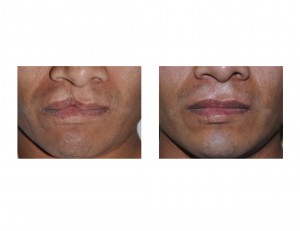Background: Cleft lip and palate deformities are a well recognized birth defects that affects around 1:1000 births. In the U.S., they commonly undergo a primary repair of the cleft lip in the first three to six months of life. Outside of the U.S., American plastic surgeons are well known to travel all over the world to use their skills to repair cleft deformities at all ages. (e.g., Operation Smile) Many of these international cleft patients are often older, some even adults, as they have never had access to plastic surgery care before.
Case Study: This 28 year-old male from Mexico presented for a cleft lip repair. He was born with a right incomplete cleft lip with no cleft palate component. He had never had any surgical efforts at repairing his obvious cleft lip.

His lip sutures were removed one week later. He was not seen again for a year after his surgery. At that time his lip was fully healed and the scars matured. The vermilion-cutaneous border was well-aligned and he had good vertical lip length along the philtral column. There was some vermilion indentation along its vertical length which was going to have a revision to add some volume by fat grafting.
Case Highlights:
1) Unrepaired or poorly repaired cleft lip and palate deformities are become more common in the U.S. with an increasing immigrant influx.
2) Cleft lip repairs in adults are just as successful as in infants with a large amount of tissue in which to work.
3) Adult cleft lip repair patients are tremendously grateful for any surgical efforts of improvement. But like infants, most primary cleft lip repairs benefit by a secondary revision for the best possible result.
Dr. Barry Eppley
Indianapolis, Indiana


